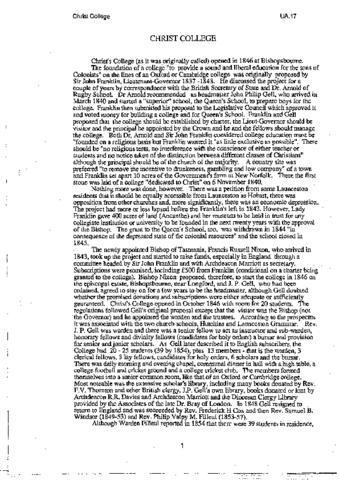Identity area
Reference code
Title
Date(s)
Level of description
Extent and medium
Context area
Name of creator
Administrative history
Christ College is the oldest tertiary institution in Australia and is a residential college of the University of Tasmania. The college is currently located on the University's grounds in Sandy Bay, Tasmania.
The College was opened on 1 October 1846 with the hope that it would develop along the lines of an Oxbridge college and provide the basis for university education in Tasmania. It was also intended to prepare men for the priesthood. The Hutchins School and Launceston Church Grammar School were founded at the same time to act as feeder schools to the College.
The College's first ten years (1846–1856) were at Bishopsbourne, and there is still a sign there pointing to "The College". However, it never really developed as its founders hoped, and a depression in the colony, the remote site, and financial problems led to its closure in 1856. The cedar mantelpiece in the Computer Room is the only reminder of the now demolished Bishopsbourne building.
1879 The College re-opened in Hobart in 1879 in Macquarie Street, moving to the Hobart High School premises on the Domain on a seven-year lease in 1885. There was an effort during the Macquarie Street/High School period to provide some form of higher education, but for most of the time the College was just another Hobart school, competing for students against schools like Hutchins and the Friends' School. It did, however, offer some evening classes, which may have been for more advanced students.
1892 The lease was not renewed in 1892 because of the foundation of the University of Tasmania. The University moved into the High School buildings and the College closed. There had been a move to restructure Christ College as the new university, but this was defeated by the combined Presbyterian and Roman Catholic interests who were sensitive to what they perceived as an undue Anglican influence on education.
1911 The College reopened in 1911 as the matriculation section of the Hutchins School in Macquarie Street. The accumulated College assets were used to build a special Christ College wing for the matriculation section, and to acquire the Holy Trinity Rectory in Park Street as a hostel for theological and other students.
The College also had a very close association with St Wilfrid's College, the theological training college founded at "Richmond Hill", Cressy, in 1904. The property was bequeathed to the Diocese by James Denton Toosey, one of the Trustees appointed after the College's closure at Bishopsbourne in 1856, with the request that it be used if possible for the revival of Christ College.
By the nineteen twenties, St Wilfrid's College had run into difficulties, and at the same time Launceston Grammar protested that Hutchins, because of its close connection with the College, was receiving an unfair amount of the Christ College assets. Representations were made to Parliament, and the Christ College Act was passed in 1926, holding that the matriculation sections of Hutchins and Launceston Grammar were carrying out the secular academic intentions of the College's founders, and granting them each one third of the College's assets. The remaining third, with the proceeds from the sale of the "Richmond Hill" estate, was to be devoted to upgrading the Holy Trinity rectory site to "....provide for the training of young men in theological learning and Christian doctrine for admission to holy orders in connection with the Church of England in Tasmania and, as far as its means will allow, to provide for a college or hostel for students attending the University of Tasmania."
1929 The Warden of St Wilfrid's College, William Barrett, was appointed first Warden of the new college, and he and his five theological students and twelve university students move into enlarged premises on the Park Street site in 1929. In 1933 the College was formally affiliated with the University as its first residential college.
Christ College 1971-Current, Sandy Bay
1971 When the University moved to the Sandy Bay campus in the sixties, the College followed. It was finally completed in 1971, when it also became the first Tasmanian college to take both men and women.
1991 Christ College began a new chapter in its long and significant story. The Bishop, the Board of Management and the Christ College Trust entered an agreement whereby ownership and management of the College passed to the University of Tasmania. The agreement provides for the continuation of the College in the full integrity of its Anglican traditions and heritage.
1996 The College celebrated its sesquicentenary.
2003 The administration of Christ College was taken over by Accommodation Services, which also administers St John Fisher College and the new University Apartments.
2008 The College completes its first major refurbishment initiative since moving to the Sandy Bay site.
From : https://en.wikipedia.org/wiki/Christ_College_(University_of_Tasmania)
Immediate source of acquisition or transfer
Content and structure area
Scope and content
Appraisal, destruction and scheduling
Accruals
System of arrangement
Conditions of access and use area
Conditions governing access
Conditions governing reproduction
Language of material
Script of material
Language and script notes
Physical characteristics and technical requirements
Finding aids
Existence and location of originals
Existence and location of copies
Related units of description
Alternative identifier(s)
Access points
Subject access points
Place access points
Name access points
Genre access points
Description identifier
Institution identifier
Rules and/or conventions used
Status
Level of detail
Dates of creation revision deletion
Language(s)
Script(s)
Sources
Digital object metadata
Latitude
Longitude
Media type
Text
Mime-type
application/pdf


